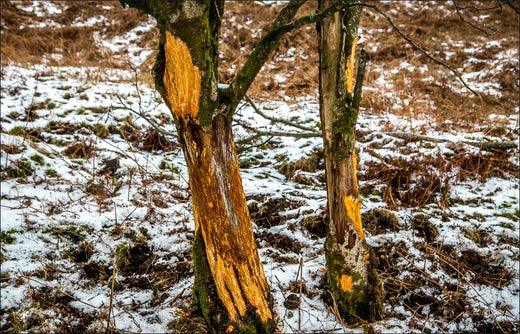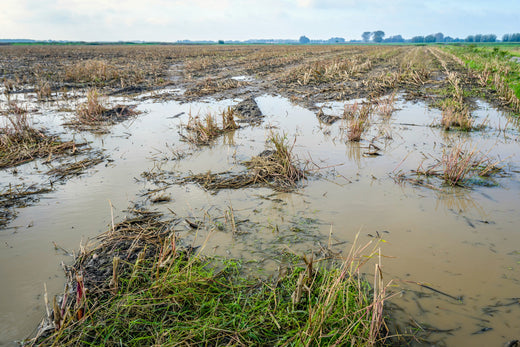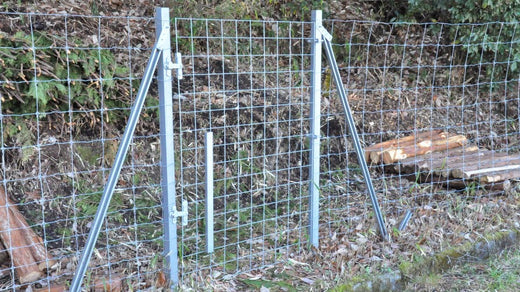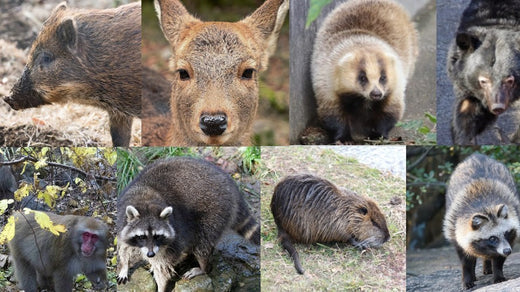Forest damage caused by deer, bears, etc. is becoming more serious as the habitats of wild birds and beasts expand. The damaged area is approximately 8,000 hectares nationwide (approximately 1,700 times the size of the Tokyo Dome), of which approximately 80% is caused by deer, and the remaining 2 are caused by non-deer (nephews, bears, antelopes, wild boars, etc.). ( quoted from the data of the Forestry Agency in 2015). 
In the newly planted area, damage to Japanese cypress, which has relatively soft leaves, is conspicuous, but all planted trees, including cedar, suffer from feeding damage. In particular, most broad-leaved trees are eaten. These feeding damages can lead to stunted growth, branching, and death of trees, which is a major obstacle to afforestation.
In addition, the loss of understory vegetation*, including seedlings that will support the future, causes the forest floor to become bare, causing soil erosion and landslides. Not only will this affect the multifaceted functions of forests, but the very existence of forests themselves may be threatened.
* Understory vegetation: A cluster of plants consisting of undergrowth (shrub) and herbaceous species in a forest. Together with the upper layer trees, it shows the vegetation characteristic of the area and serves as an index for understanding the environment of the area.
In addition, along with the increase in beasts that cause forest damage, the number of mountain bir and ticks is also increasing. Yamabiru used to inhabit the interior of mountains, but due to the expansion of the distribution of deer, etc., their habitat has expanded to the foot of mountains. In addition, many ticks tend to live in environments where wild animals appear, and the increase in wild animals is causing more damage.
Since the extermination of ticks and leeches is inextricably linked with the increase in beasts such as deer, it is not possible to reduce them suddenly.Forest damage caused by deer
Deer tend to prefer flat land to mountains, so in the past there were more deer inhabiting flat land than in mountains. However, due to human development, deer now live in the mountains. It prefers deforested areas with plenty of undergrowth to feed on, and forest environments with sparsely hidden trees.
In addition, it prefers flat land along ridges and gentle slopes with good sunlight, and damage to forests in such places is conspicuous. The deer habitat distribution has expanded significantly since the end of World War II, and according to a survey that began in 1978, the distribution area has expanded about 2.5 times over the past 36 years.
In particular, the expansion of areas with heavy snowfall, such as the Tohoku region and the Sea of Japan side, is conspicuous. Deer have a high fertility, and females will become pregnant every year if the food conditions are favorable.
As of the end of 2013, the number of deer population exceeded 3 million, showing an increase of almost 10 times the number in 1989 ( citing data from the Forestry Agency ). . Furthermore, it is predicted that the current capture rate will increase 1.5 times to 4.53 million in 10 years (FY2023).
 Deer damage in forests includes feeding damage to planted trees on reclaimed land. In forests in areas with high deer populations, deer will eat anything if they are hungry, so the foliage, bark, and even undergrowth that can be reached by the deer's mouth may be nearly gone.
Deer damage in forests includes feeding damage to planted trees on reclaimed land. In forests in areas with high deer populations, deer will eat anything if they are hungry, so the foliage, bark, and even undergrowth that can be reached by the deer's mouth may be nearly gone.
Bark stripping by deer is also a serious problem of forest damage. Bark is obtained by deer eating the bark and cambium, and by scraping the male's horns. Trees damaged by barking can become infected, and the lower parts of damaged trees are often damaged, reducing the quality of the most valuable part of the tree, which is a serious problem for foresters.
Forest damage caused by non-deer
Forest damage is also caused by bears, field mice, hares, and Yezo deer, although the percentage is not as high as that caused by deer.
Forest damage caused by field rats and hares
Among the field mice, the species that cause damage are the Ezo pygmaeus and the Pleurotus musculus, and they feed on the bark and underground roots of planted trees. The Ezo lycopod is a subspecies of the Eurasian yule that is widely distributed in the Eurasian continent, and inhabits only Hokkaido in Japan.
In Japan, damage to the forestry industry by field rats is not a major problem, except in Hokkaido. In general, Japanese larch and Japanese cedar are more susceptible to damage than these, while dolphin pine, Sakhalin spruce, and Sakhalin fir are less susceptible to damage, but damage to all tree species has been reported.
As for forest damage caused by hares, it is speculated that only a portion of the damage has been reported, as it is rare for hares to die over a wide area. Since damaged trees often survive even after being damaged, the actual situation is not fully understood.
In particular, broad-leaved trees are said to be susceptible to hares.
Forest damage caused by bears and Yezo deer
Yezo deer is a subspecies of the sika deer that is distributed in the Japanese archipelago and the eastern part of the Eurasian continent, and is the largest of the sika deer in the Japanese archipelago. It used to be widely distributed in Hokkaido, but the population decreased due to overhunting and heavy snow in the Meiji period. However, in recent years, the population that remained in the eastern part of Hokkaido and the Hidaka region has increased rapidly.
Many damages caused by Yezo deer have been reported on broad-leaved trees and larch trees. Broad-leaved trees are planted in a small area, so the damaged area is small, but it can be said that the percentage of damage is high. Tree species that are susceptible to sika deer damage differ somewhat from region to region, and tree species that are undamaged in one region may suffer concentrated feeding damage in another region. there is.
Forest damage caused by bears is "bear stripping," in which the bark of standing trees is stripped and the bark of older trees is stripped off with teeth and claws. It causes damage such as withering of standing trees and a decrease in value as wood. In particular, there is a tendency for large-diameter trees, which are at or above the appropriate felling season, to be significantly damaged. Due to the large economic loss, it also has a large impact on the willingness of forest owners to manage their forestry business.
In addition, nuts (acorns such as Quercus crispula and beech nuts), which are one of the main foods for bears, alternate between good and bad harvests in a cycle of several years. There is an increasing tendency.
Other forest damage
Wild boars cause a lot of damage in agriculture, but in forests, the main damage is feeding damage to bamboo shoots in bamboo forests and feeding damage to shiitake mushrooms.
The main damage caused by serows is feeding on the branches and leaves of young trees, but in some areas they also scrape the horns of older trees. Infested juvenile trees die or their growth is severely inhibited. Damage to forests caused by serows has decreased significantly after peaking at about 3,000 hectares in the early 1970s.
Importance of Comprehensive Wildlife Control
From the standpoint of conserving forest ecosystems and biodiversity, even wild birds and beasts that cause forest damage cannot be completely excluded from the forest or eradicated.
In addition, it is considered extremely difficult to solve the fundamental problem of animal damage control in forest areas by simply using control technologies such as protective fences as they are in farmlands and residential areas. This is because deer roam freely in the vast forest, and the terrain, such as slopes, and the weather conditions, such as the amount of snow, vary greatly. Therefore, it is necessary to comprehensively promote the following measures.
For example, in Tanzawa, Kanagawa Prefecture, many small vegetation protection fences had been installed for more than 10 years, and it was found that the older the fences were installed, the more perennial herbs, including endangered species, and stag mushrooms recovered. .
However, considering the cost of installation and maintenance, there is a limit to the effectiveness of vegetation protection fences, and there is a strong demand for linkage with population control. Hunting associations and local governments continue to make efforts to capture the animals in each region, but the current situation is that we must devise a comprehensive implementation system for animal damage control.

 箱罠
箱罠
 くくり罠
くくり罠
 パーツ類
パーツ類
 電気柵
電気柵
 自作キット
自作キット
 防獣グッズ
防獣グッズ
 監視カメラ
監視カメラ




 box trap
box trap
 tying trap
tying trap
 enclosure trap
enclosure trap
 Prevention and avoidance goods
Prevention and avoidance goods
 electric fence
electric fence
 trap surveillance camera
trap surveillance camera
 transportation goods
transportation goods
 Trap detection sensor
Trap detection sensor
 hunting supplies
hunting supplies
 hunting books
hunting books
 Anti-bird goods
Anti-bird goods
 Agricultural materials/machinery
Agricultural materials/machinery
 boar
boar
 deer
deer
 Kyon
Kyon
 monkey
monkey
 raccoon
raccoon
 Badger
Badger
 palm civet
palm civet
 raccoon dog
raccoon dog
 nutria
nutria
 mouse or rat
mouse or rat
 Mole
Mole
 bear
bear
 pigeon
pigeon
 Crow
Crow







